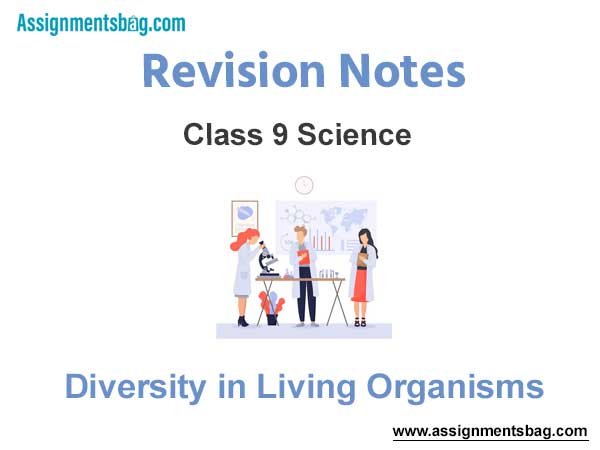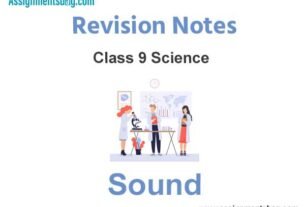Please refer to the Diversity in Living Organisms Revision Notes given below. These revision notes have been designed as per the latest NCERT, CBSE and KVS books issued for the current academic year. Students will be able to understand the entire chapter in your class 9th Science book. We have provided chapter wise Notes for Class 9 Science as per the latest examination pattern.
Revision Notes Chapter 7 Diversity in Living Organisms
Students of Class 9 Science will be able to revise the entire chapter and also learn all important concepts based on the topic wise notes given below. Our best teachers for Grade 9 have prepared these to help you get better marks in upcoming examinations. These revision notes cover all important topics given in this chapter.
1. Each organism is different from all other organisms.
2. In this activity, we decide which characteristics (we can run, but the Banyan tree can’t run is a characteristic) are important in forming the desired category.
3. Greek thinker Aristotle classified animals according to whether they lived on land, in water or in air. This classification is a landmark in ideology, but has limitations. For example,animals that live in the sea include Corals, Whales, Octopus, Starfish, and Shark. In fact they are different from each other.
4. Classification and Evolution: organisms are classified based on body design, hierarchy in developing, relation to evolution. Charles Darwin first described the idea of evolution in 1859 in his book “ The Origin of Species”
5. The Biologists, such as Haeckel, Whittaker & Carl Woese tried to classify all living organisms into broad Kingdoms. The Whittaker proposed five kingdoms: Monera, Protista, Fungi, Plantae and Animalia. Carl Woese introduced by dividing Monera into Archaebacteria and Eubacteria.
6. Hierarchy of Classification :
7. Monera: They have unicellular, Prokaryotic organisms (do not have defined nucleus or organelles). The cell wall may or may not present. The mode of nutrition is autotrophic (synthesizing food on their own) (or)heterotrophic (getting food from environment). Ex. Bacteria, Anabaena.
8. Protista: They have unicellular eukaryotic organisms (do have well defined nucleus or organelles). The body is covered by cilia, flagella for locomotion. The mode of nutrition is autotrophicorheterotrophic. Ex. Diatoms, protozoans.
9. Fungi: These are multi-cellular eukaryotic organisms with cell wall, made up of Chitin.
They do not perform Photosynthesis (heterotrophic), Saprophytic (derive nutrition from decaying material). Ex. Aspergillus, Penicillium, Mushroom, Rhizopus. The fungi living with algae forms Lichen (Symbiotic Association).
10. Plantae: These are multi-cellular eukaryotic organisms with cell wall, made up of Cellulose.
Able to perform photosynthesis (autotrophic). Ex. Rice, wheat.
11. Animalia:These are multi-cellular eukaryotic organisms without cell wall. They are not able to perform photosynthesis (heterotrophic).
Ex. Human beings, Peacock.
DETAILS OF KINGDOM PLANTAE
1. The kingdom Plantae is further classified as Thallophyta, Bryophyta, Pteridophyta, Gymnosperms, Angiosperms .
2.Thallophyta: The plants do not have well defined body design, commonly called as” Algae”, mostly aquatic. Ex. Spirogyra, Ulothrix.
3.Bryophyta: These are commonly called as the “Amphibians of Kingdom”. The plant body is differentiated into roots like, stem like and leaf like structures. No specialized tissues for the conduction of water and food.Ex. Marchantia, Funaria.
4. Pteridophyta: These are commonly called as the “First vascular land plants ”. The plant body is differentiated into root, stem and leaf. Specialized tissues for the conduction of water and food are developed in these plants. The reproductive organs are inconspicuous. Ex. Marsilea, Fern.
Special Note: The reproductive organs are inconspicuous in Thallophyta, Bryophyta, Pteridophyta are can’t develop seeds. They are together called as” Cryptogamae (Non- Flowering Plants)”. The plants with well differentiated reproductive organs and that ultimately make seeds are called” Phanerogams (Flowering Plants)”. This group is further classified Gymnosperms (Bear naked Seeds) &Angiosperms (Bears seeds inside Fruit).
5. Gymnosperms: These are commonly called as “Naked seed bearing plants”. They areusually perennial, evergreen and woody. Ex. Pinus, Cycas
6. Angiosperms: These are commonly called as “Enclosed seed bearing plants”. Plants with seeds having a single cotyledon are called as” Monocotyledons or Monocots”. Plants with seeds having two cotyledons are called as “Dicots”. Ex. Ipomoea, Paphiopedium.
These are Eukaryote, multicultural and hetero-tropic.
They are further classified as Non- Chordates( Porifera, Coelenterata, Platyhelminthes ,
Nematoda, Annelida, Arthropoda, Mollusca, Echinodermata) and Chordates { Protochordata, Vertebrata ( Pisces, Amphibians, Reptilia, Aves, Mammalia)} .
I.Non- Chordates
1. Porifera: The word Porifera” means organisms with holes”. The canal system helps in circulating water, food, oxygen. They are non-motile with cellular level of organization and mainly marine organisms with hard outer coat called as Skeleton. They are commonly called as Sponges. Ex. Spongilla, Sycon
2. Coelenterata: The word Coelenterata” means organisms with body cavity calledCoelenteron” . They are radially symmetrical, Diploblastic ( two layers of cells), commonly called as Cnidarians ( Stinging cells for protection are present in the body). Ex. Hydra, Sea Anemone
3. Platyhelminthes: The word Platyhelminthes means organisms with flatworms ( dorsocentrally flattened)”.They are bilaterally symmetrical Triploblastic( three layers ofcells ), either free-living or parasitic. No true Coelom is present – Acoelomates. Ex. Planaria( Free living) , Tape worm( Parasitic)
4. Nematoda: The word Nematoda “means organisms with roundworms”. They are bilaterally symmetrical Triploblastic ( three layers of cells ), familiar with parasitic worms. The falseCoelom is called as Pseudocoelome. Ex. Ascaris, Wuchereria (Filarial worm causes elephantiasis).
5.The word Annelida“ means organisms with metameric-segmented”. They are bilaterally symmetrical Triploblastic(three layers of cells) with closed circulatory system, familiar with earth worms. The Coelom is called as true Coelom. Ex. Neris, Earth worm, Leech
6. Arthropoda: The word Arthropoda “means organisms with jointed legs” They are bilaterally symmetrical Triploblastic(three layers of cells ), familiar with cockroaches. The Coelom is blood filled called as Haemo Coelom. Ex. Prawn, Scorpion, Housefly
7.Mollusca: The word Mollusca “means organisms with soft body” They are bilaterally symmetrical, Triploblastic(three layers of cells), familiar with Octopus, Pila. Foot is for moving, kidney like organ for excretion, with open circulatory system. Ex. Unio, chiton
8. Echinodermata: The word Echinodermata “means organisms with spiny skinned”. Exoskeleton is with calcium carbonate. They are radially symmetrical Triploblastic ( three layers of
cells ) with coelomic cavity, familiar with Star fish. They are exclusively free-living marine animals. Ex. Sea Cucumber, Feather Star
II.Chordates: They are further classified as two major groups such asP rotochordata& Vertebrata
(A).Protochordata: Notochord present in at least larval forms, but very rudimentary. It is a rod like supporting structure, runs along with nervous tissue from the gut of animal. They
are bilaterally symmetrical, triploblastc(three layers of cells) with a Coelom, familiar with Amphioxus. Ex. Balanoglossus
(B).Vertebrata: Notochord is replaced by vertebral column and internal skeleton. They are bilaterally symmetrical, triploblastic, coelomic and segmented having paired gill pouches.
Vertebrates are grouped into five classes.
1. Pisces: These are commonly called as “fishes”, exclusively aquatic. Body is streamlined and a tail for locomotion. Gills for respiration, heart is two chambered, cold blooded, skin is covered with scales, plates. They are cold-blooded animals. Skeleton of bone ( Rohu) / cartilage( Shark). They lay eggs. Ex. Lion Fish, Dog Fish .
2. Amphibians: These are commonly called as “Amphibians” because they can live on land and in water”. Body is streamlined and a webbed foot/ foot for locomotion. Gills or lungs or skin for respiration, heart is three chambered, cold blooded, skin is lack of scales, plates. They are coldblooded animals. They lay eggs. Ex. Rana, Hyla.
3. Reptilia: These are commonly called as “Reptilians”. A lung for respiration, heart is three chambered (Crocodile heart is four chambered), skin have scales. They are cold-blooded animals. They lay eggs. Ex. Snakes, Turtles.
4. Aves :These are commonly called as “Birds”. A lung for respiration, heart is four chambered, fore limbs are modified for flight, skin has feathers. They are warm-blooded animals. They lay eggs. Ex. Ostrich (Flightless Bird), Pigeon, Sparrow
5. Mammalia: These are commonly called as “animals with mammary glands for producing milk to nourish their young ones”. A lung for respiration, heart is four chambered, skin has hairs, sweat or oil glands. They are warm-blooded animals. They lay eggs (Platypus, Echidna), give birth to young ones poorly developed (Kangaroo) & give birth to developed young ones (Human beings). Ex. Lion, Whale, Bat.
DETAILS OF NOMENCLATURE
Nomenclature: The system of scientific naming or nomenclature was introduced by Carolus Linnaeus. It is unique to identify in the world. We limit ourselves to writing the names of the Genus and Species of that particular organism. The world over, it has been agreed that both these names will be used in Latin forms.When printed is given in italics and when written by hand, the Genus and Species name have to be underlined separately.
Ex. Ostrich (Common name):Struthiocamelus(scientific name with two parts namely the Genus and Species).
Important Question and Answer :
Question. The warm-blooded animals with fore limbs modified for flight, skin has feathers are called as…………………..
Answer
Aves/Birds
Question.Monera members areunicellular, Prokaryotic organisms, mention …..
Answer
TRUE
Question. Who proposed the five kingdoms such as, Monera, Protista, Fungi, Plantae and Animalia?
Answer
Whittaker
Question. TheAnabaena belongs to the kingdom …………………
Answer
Monera
Question. What is the book written by Charles Darwin?………………….
Answer
The Origin of Species
Question……………………. are commonly called as the“Amphibians of Plant Kingdom”.
Answer
Bryophyta
Question. The Diatoms belongs to the kingdom……………..
Answer
Protista


